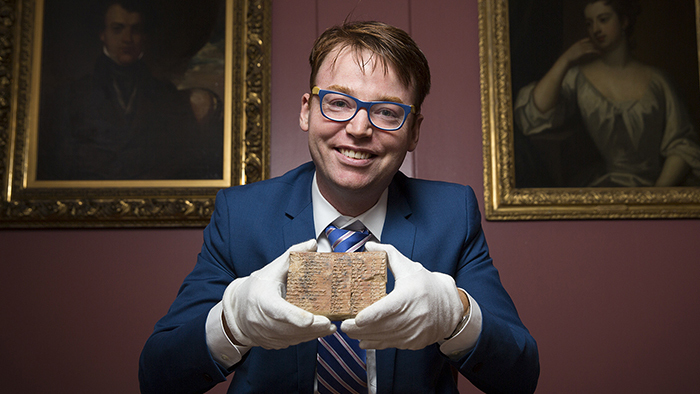A Babylonian clay tablet dated back to 3,700 years has been identified as the world’s oldest and the most accurate trigonometric table, suggesting the Babylonians beat the ancient Greeks to the invention of trigonometry by over 1,000 years.

The Babylonian clay tablet, Plimpton 322. Notable as containing an example of Babylonian mathematics. It has number 322 in the G.A. Plimpton Collection at Columbia University.
The tablet, known as Plimpton 322, was discovered in the early 1900s in what is now southern Iraq. This tablet, believed to have been written about 1800 BC, has a table of four columns and 15 rows of numbers in the cuneiform script of the period. But since its discovery, researchers have been baffled about what its actual purpose was.
However, in 2017, a team of researchers from the University of New South Wales (UNSW) in Australia finally solved the mystery behind Plimpton 322.

Researcher Daniel Mansfield and Plimpton 322. Credit: UNSW
Their research reveals that Plimpton 322 describes the shapes of right-angle triangles using a novel kind of trigonometry based on ratios, not angles and circles. It is a fascinating mathematical work that demonstrates undoubted genius.
Babylonian mathematics used a base 60 or sexagesimal system (like the minute markers on a clock face), rather than the base 10 or decimal system we use today.
The reason is that a sexagesimal system has more exact fractions than a decimal system, which means less rounding up. While only two numbers can divide 10 with nothing leftover – 2 and 5 – a base 60 system has far more. It can be divided by 2, 3, 4, 5 and 6.
Cleaner fractions mean fewer approximations and more accurate maths, and the researchers suggest we can learn something from it today.
If the new study is right, the Greek astronomer Hipparchus, who lived about 120 BC, is not the father of trigonometry that he’s long been regarded as. Scholars date the tablet to around 1822-1762 BC as the renowned historian Eleanor Robson suggested in her paper “Words and Pictures: New Light on Plimpton 322” in February 2002.
Now, the researchers conclude the tablet may well have been used by ancient scribes to make calculations for constructing palaces, temples, and canals. Therefore, Plimpton 322 proves that the Babylonians had a great and the most accurate architectural knowledge in their time.
Src: mysteriesrunsolved.com








